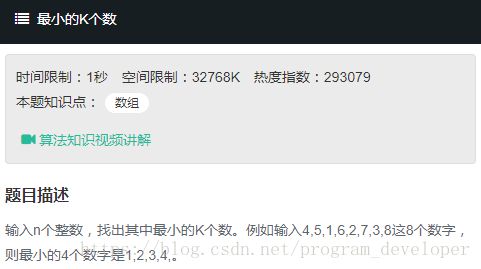牛客网在线编程专题《剑指offer-面试题30》最小的K个数
我的个人微信公众号:Microstrong
微信公众号ID:MicrostrongAI
微信公众号介绍:Microstrong(小强)同学主要研究机器学习、深度学习、计算机视觉、智能对话系统相关内容,分享在学习过程中的读书笔记!期待您的关注,欢迎一起学习交流进步!
知乎主页:https://www.zhihu.com/people/MicrostrongAI/activities
Github:https://github.com/Microstrong0305
个人博客:https://blog.csdn.net/program_developer
题目链接:
https://www.nowcoder.com/practice/6a296eb82cf844ca8539b57c23e6e9bf?tpId=13&tqId=11182&tPage=2&rp=2&ru=/ta/coding-interviews&qru=/ta/coding-interviews/question-ranking
题目:
解题思路:
(1)方法一:利用快排对输入数字进行排序,然后取最小的k个数。
已经AC的代码:
# -*- coding:utf-8 -*-
class Solution:
def GetLeastNumbers_Solution(self, tinput, k):
if len(tinput) < k or len(tinput) == 0:
return []
list = self.Sort(tinput, 0, len(tinput) - 1)
return list[0:k]
def Sort(self, array, low, high):
if low < high:
index = self.partition(array, low, high)
self.Sort(array, low, index - 1)
self.Sort(array, index + 1, high)
return array
def partition(self, array, low, high):
key = array[low]
while low < high:
while low < high and array[high] >= key:
high = high - 1
array[low] = array[high]
while low < high and array[low] <= key:
low = low + 1
array[high] = array[low]
array[high] = key
return high
if __name__ == '__main__':
list = [4, 5, 1, 6, 2, 7, 3, 8]
solution = Solution()
print(solution.GetLeastNumbers_Solution(list, 4))第一次写的时候没有通过,是因为快排边界条件写错了,没有考虑等号的情况,造成程序未在规定的时间内运行结束。错误代码如下:
while low < high:
while low < high and array[high] > key:
high = high - 1
array[low] = array[high]
while low < high and array[low] < key:
low = low + 1
array[high] = array[low]已经AC的Java代码:
import java.util.*;
public class Solution {
public ArrayList GetLeastNumbers_Solution(int [] input, int k) {
ArrayList arr=new ArrayList<>();
if(input.length=mid && left Python快排聪明人的写法,AC通过:
# -*- coding:utf-8 -*-
class Solution:
def GetLeastNumbers_Solution(self, tinput, k):
def quick_sort(lst):
if not lst:
return []
pivot = lst[0]
left = quick_sort([x for x in lst[1:] if x < pivot])
right = quick_sort([x for x in lst[1:] if x >= pivot])
return left + [pivot] + right
if tinput == [] or k > len(tinput):
return []
tinput = quick_sort(tinput)
return tinput[: k]
if __name__ == '__main__':
list = [4, 5, 1, 6, 2, 7, 3, 8]
solution = Solution()
print solution.GetLeastNumbers_Solution(list, 4)(2)方法二:基于Partition函数O(n)的算法
利用快速排序中的获取分割(中轴)点位置函数partition。
基于数组的第k个数字来调整,使得比第k个数字小的所有数字都位于数组的左边,比第k个数字大的所有数字都位于数组的右边。调整之后,位于数组左边的k个数字就是最小的k个数字(这k个数字不一定是排序的)。时间复杂度为:O(N)。
第一次写不通过,因为快排边界条件写错了,没有考虑等号的情况。(错误同方法一)
第二次写不通过,因为牛客网要求输出的结果必须也是排好序的,因此最终结果又用sorted()函数排一下序。
第三次,终于通过啦!
已经AC的Python代码:
class Solution:
def GetLeastNumbers_Solution(self, tinput, k):
# write code here
# 空列表
if tinput == None or len(tinput) == 0 or len(tinput) < k:
return []
index = self.partition(tinput, 0, len(tinput) - 1)
while index != k - 1:
if index > k - 1:
index = self.partition(tinput, 0, index - 1)
else:
index = self.partition(tinput, index + 1, len(tinput) - 1)
return sorted(tinput[:k])
def partition(self, numList, low, high):
key = numList[low]
while low < high:
while low < high and numList[high] >= key:
high -= 1
numList[low] = numList[high]
while low < high and numList[low] <= key:
low += 1
numList[high] = numList[low]
numList[high] = key
return high
if __name__ == '__main__':
list = [4, 5, 1, 6, 2, 7, 3, 8]
solution = Solution()
print(solution.GetLeastNumbers_Solution(list, 4))已经AC的C++代码:
class Solution {
public:
void swap(int &fir,int &sec)
{
int temp = fir;
fir = sec;
sec = temp;
}
int getPartition(vector &input,int start,int end)
{
if(input.empty() || start>end) return -1;
int temp = input[end];
int j = start - 1;
for(int i=start;i GetLeastNumbers_Solution(vector input, int k)
{
vector result;
if(input.empty() || k>input.size() || k<=0) return result;
int start = 0;
int end = input.size()-1;
int index = getPartition(input,start,end);
while(index != (k-1))
{
if(index > (k-1))
{
end = index - 1;
index = getPartition(input,start,end);
}
else
{
start = index + 1;
index = getPartition(input,start,end);
}
}
for(int i=0;i 总结:这种思路虽时间复杂度不错,但会修改输入数组,且一般也不易想到。更容易想到的是利用堆排序。
(3)方法三:堆排序,O(N logK),适合处理海量数据。
用最大堆保存这k个数,每次只和堆顶比,如果比堆顶小,删除堆顶,新数入堆。
1) 遍历输入数组,将前k个数插入到堆中;
2) 继续从输入数组中读入元素做为待插入整数,并将它与堆中最大值比较:如果待插入的值比当前已有的最大值小,则用这个数替换当前已有的最大值;如果待插入的值比当前已有的最大值还大,则抛弃这个数,继续读下一个数。
这样动态维护堆中这k个数,以保证它只储存输入数组中的前k个最小的数,最后输出堆即可。
Python通过代码:
class Solution:
def GetLeastNumbers_Solution(self, tinput, k):
# write code here
def siftup(lst, temp, begin, end):
if lst == []:
return []
i, j = begin, begin * 2 + 1
while j < end:
if j + 1 < end and lst[j + 1] > lst[j]:
j += 1
elif temp > lst[j]:
break
else:
lst[i] = lst[j]
i, j = j, 2 * j + 1
lst[i] = temp
def heap_sort(lst):
if lst == []:
return []
end = len(lst)
for i in range((end // 2) - 1, -1, -1):
siftup(lst, lst[i], i, end)
for i in range(end - 1, 0, -1):
temp = lst[i]
lst[i] = lst[0]
siftup(lst, temp, 0, i)
return lst
if tinput == [] or k > len(tinput):
return []
tinput = heap_sort(tinput)
return tinput[: k]Java通过代码:
import java.util.ArrayList;
public class Solution {
public ArrayList GetLeastNumbers_Solution(int [] input, int k) {
ArrayList list=new ArrayList();
//检查输入的特殊情况
if(input==null || input.length<=0 || input.length=0; len--){
adjustMaxHeapSort(input,len,k-1);
}
//从第k个元素开始分别与最大堆的最大值做比较,如果比最大值小,则替换并调整堆。
//最终堆里的就是最小的K个数。
int tmp;
for(int i=k; itemp){
input[pos]=input[child];
}else{
break;
}
}
input[pos]=temp;
}
} 我们自己从头实现一个最大堆需要一定的代码量,这在面试短短的几十分钟内很难完成。我们可以借助于Python中实现了最小堆的heapq库。因为在一个数组中,每个数取反,则最大数变成了最小数,整个数字的顺序发生了变化,所以可以给数组的每个数字取反,然后借助最小堆,最后返回结果的时候再取反就可以了。
- heapq.heappush(res, -i) 意为:向堆res中添加一个元素-i
- heapq.heappushpop(res, -i)意为:将元素-i与堆顶的元素比较。如果该元素值大于堆顶元素,则将该元素与堆顶元素替换。否则不改变堆元素。
已经AC的代码:
# -*- coding:utf-8 -*-
import heapq
class Solution:
def GetLeastNumbers_Solution(self, tinput, k):
# write code here
if len(tinput) < k:
return []
res = []
for i in tinput:
heapq.heappush(res, -i) if len(res) < k else heapq.heappushpop(res, -i)
return sorted(list(map(lambda x: -x, res)))再来一种更简便的写法:
- heapq.nlargest(n, iterable, key=None) 返回最大的n个元素(Top-K问题)
- heapq.nsmallest(n, iterable, key=None) 返回最小的n个元素(Top-K问题)
已经AC的代码:
# -*- coding:utf-8 -*-
import heapq
class Solution:
def GetLeastNumbers_Solution(self, tinput, k):
# write code here
if len(tinput) < k:
return []
return heapq.nsmallest(k, tinput)总结:
1.如果用快速排序,时间复杂度为 O(nlogn)。
2.基于Partition函数的时间复杂度为O(n)。
3.基于堆排序算法,构建最大堆的时间复杂度为 O(nlogk)。
4.如果用冒泡排序,时间复杂度为 O(n*k)。
Reference
【1】《剑指offer》,何海涛著。
【2】剑指offer:最小的K个数(Python),地址:https://blog.csdn.net/u010005281/article/details/80084994
【3】【剑指Offer】最小的K个数 解题报告(Python),地址:https://blog.csdn.net/fuxuemingzhu/article/details/79637795
【4】窥探算法之美妙——寻找数组中最小的K个数&python中巧用最大堆,地址:https://www.cnblogs.com/cotyb/p/5205123.html
